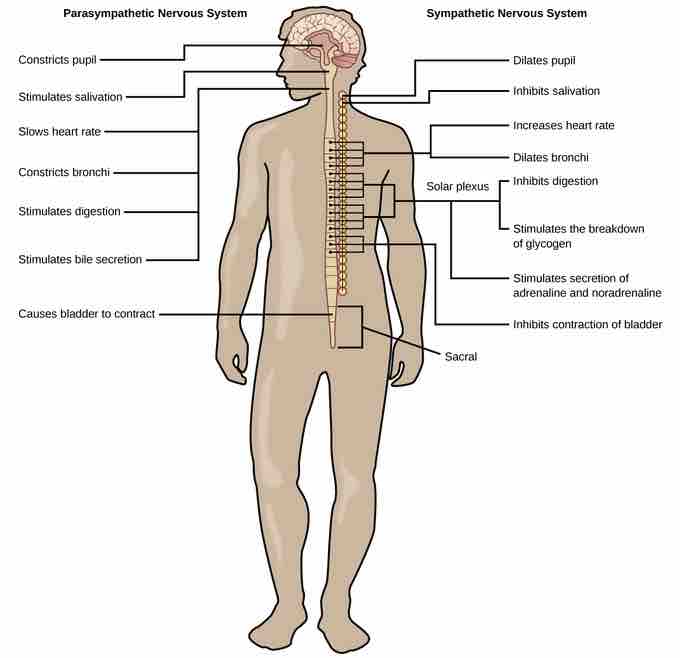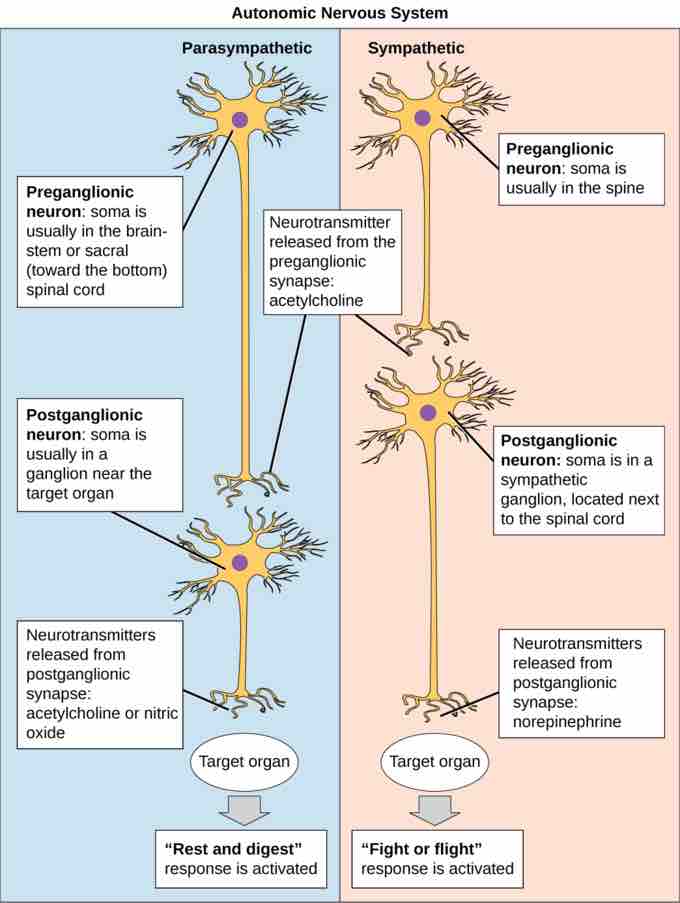Autonomic Nervous System
The autonomic nervous system (ANS) serves as the relay between the central nervous system (CNS) and the internal organs. It controls the lungs, the heart, smooth muscle, and exocrine and endocrine glands, largely without conscious control. It can continuously monitor the conditions of these different systems and implement changes as needed. Signaling to the target tissue usually involves two synapses. A preganglionic neuron (originating in the CNS) synapses to a neuron in a ganglion that, in turn, synapses on the target organ . There are two divisions of the autonomic nervous system that often have opposing effects: the sympathetic nervous system and the parasympathetic nervous system .

Actions of the SNS and PNS
The sympathetic and parasympathetic nervous systems often have opposing effects on target organs.

Autonomic nervous system
Autonomic responses are mediated by the sympathetic and the parasympathetic systems, which are antagonistic to one another. The sympathetic system activates the "fight or flight" response, while the parasympathetic system activates the "rest and digest" response. In the autonomic nervous system, a preganglionic neuron of the CNS synapses with a postganglionic neuron of the parasympathetic nervous system. The postganglionic neuron, in turn, acts on a target organ.
Sympathetic Nervous System
The sympathetic nervous system is responsible for the "fight or flight" response that occurs when an animal encounters a dangerous situation. One way to remember this is to think of the surprise a person feels when encountering a snake ("snake" and "sympathetic" both begin with "s"). Examples of functions controlled by the sympathetic nervous system include an accelerated heart rate and inhibited digestion, both of which help prepare an organism's body for the physical strain required to escape a potentially dangerous situation or to fend off a predator.
Most preganglionic neurons in the sympathetic nervous system originate in the spinal cord. The axons of these neurons release acetylcholine on postganglionic neurons within sympathetic ganglia (the sympathetic ganglia form a chain that extends alongside the spinal cord). The acetylcholine activates the postganglionic neurons. Postganglionic neurons then release norepinephrine onto target organs. As anyone who has ever felt a rush before a big test, speech, or athletic event can attest, the effects of the sympathetic nervous system are quite pervasive. This is both because one preganglionic neuron synapses on multiple postganglionic neurons, amplifying the effect of the original synapse, and because the adrenal gland also releases norepinephrine (and the closely-related hormone epinephrine) into the blood stream. The physiological effects of this norepinephrine release include dilating the trachea and bronchi (making it easier for the animal to breathe), increasing heart rate, and moving blood from the skin to the heart, muscles, and brain (so the animal can think and run). The strength and speed of the sympathetic response helps an organism avoid danger. Scientists have found evidence that it may also increase long term potentiation in neurons, allowing the animal to remember the dangerous situation and avoid it in the future.
Parasympathetic Nervous System
While the sympathetic nervous system is activated in stressful situations, the parasympathetic nervous system allows an animal to "rest and digest." One way to remember this is to think that during a restful situation like a picnic, the parasympathetic nervous system is in control ("picnic" and "parasympathetic" both start with "p"). Parasympathetic preganglionic neurons have cell bodies located in the brainstem and in the sacral (toward the bottom) spinal cord. The axons of the preganglionic neurons release acetylcholine on the postganglionic neurons, which are generally located very near the target organs.
The parasympathetic nervous system resets organ function after the sympathetic nervous system is activated (the common adrenaline dump you feel after a ‘fight-or-flight' event). Effects of acetylcholine release on target organs include slowing of heart rate, lowered blood pressure, and stimulation of digestion.